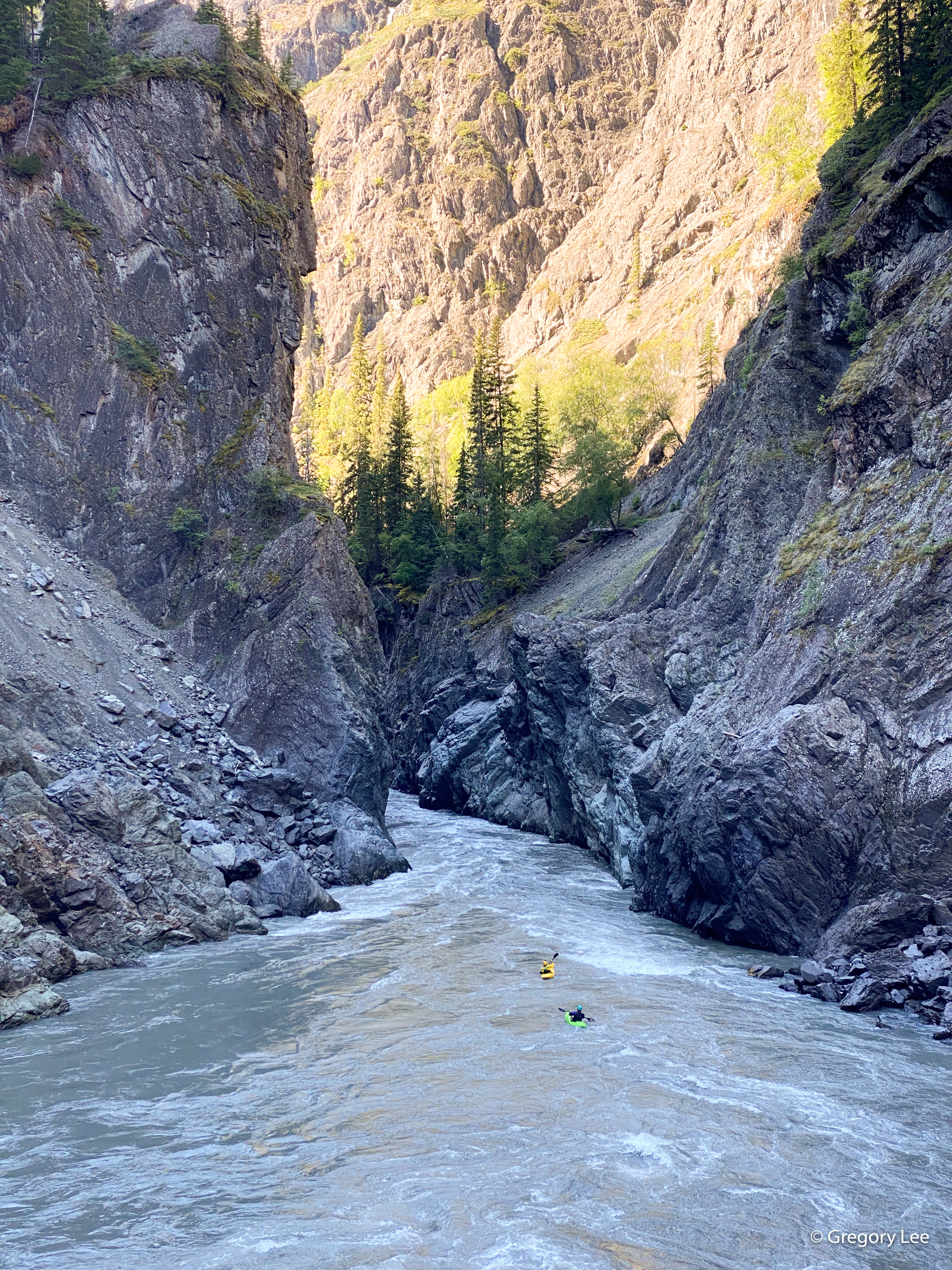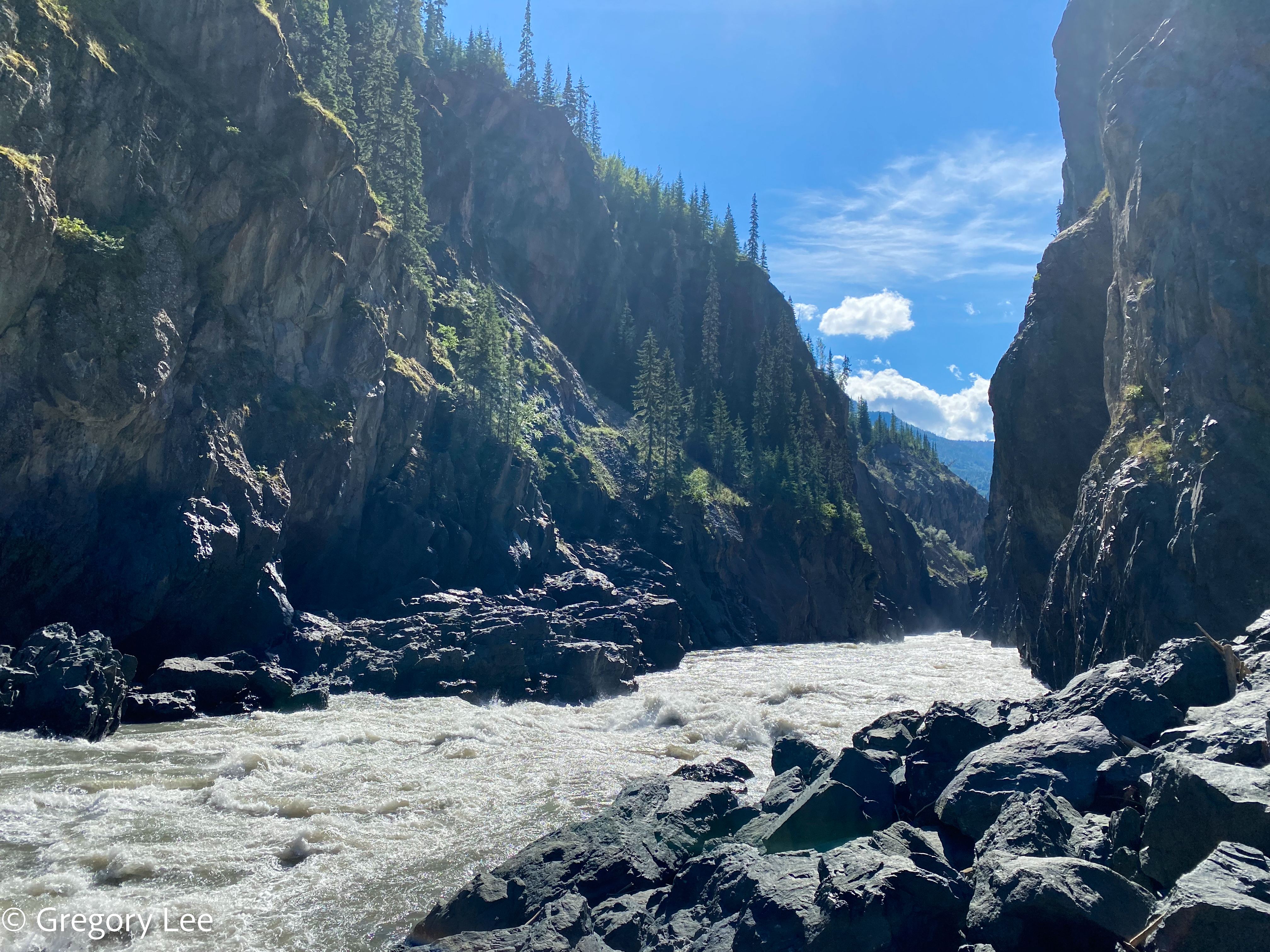- Published on
Fear
*DRAFT*
- Authors
“I don’t see a line,” I told Matt and Axel, as they pulled me back to shore from my scout. We were at The Wall, one of the biggest rapids on The Grand Canyon of the Stikine, and one that cannot be portaged. I had just come back from scouting, which required a traverse above the river across loose rock. As I was climbing, both my left hand and right foot hold broke, dumping me in the river, right above the rapid. Luckily I was able to grab holds on the wall again and clamber out on shore. Sketchy. We had been told that the rapid was runnable left of center. But, as I looked downstream at the rapid, all I could see was a huge hole, backed up by the biggest pillow I’d ever seen. It looked like certain death. The river had dropped a bit overnight: was it possible that the rapid was no longer runnable due to the changing water levels?
The Wall is so-named because the canyon walls tower above the rapid. 500 foot tall, sheer walls drop all the way down to the water, and constrict the river into an angry, frothing maw. There is no escape: the only way out is downriver, through the chaos. After seeing the look on my face, Matt decided to scout the rapid for himself. We roped him through the traverse, and he came back looking like he’d seen a ghost. He agreed with my assessment, the rapid didn’t look runnable. Axel, always the enthusiast, thought we would flush downstream eventually. But, he sounded like he was trying to convince himself as much as us. So, we looked around for other options. Across the river, we saw a steep slope that offered potential egress from the canyon. However, we soon realized that it was a 60 degree slope of loose rock, with the possibility of vertical moves near the top. Falls looked probable, and would have been deadly. Clearly, climbing out would be more dangerous than whatever lay downstream. We would have to run the rapid.
In my 10+ year career in whitewater, I have never dropped into a rapid that I didn’t think I could navigate safely. I’ve never committed to a rapid where I thought the most likely outcome was a swim, and a swim in the Grand Canyon of the Stikine is always life threatening. I have never been that scared in a kayak: I legitimately and rationally thought I might die in the next 5 minutes. But, as I dropped in, I reached a state of zen. If this was my time, so be it. I was doing something I loved in a superlative place. Nothing that I’d read or heard about the run indicated that we would be in this situation. There was no way I would have avoided being in that moment, given the available information. So, I took some deep breaths, the fear fell away, and I committed.
 |
|---|
| Entering the canyon above the Wall |
Fear
Fear is an integral part of kayaking. It is a natural response to operating in an environment that is foreign, chaotic, uncomfortable, and obviously more powerful than you. Many of the beginners I’ve taught will panic the first time they flip over. When you first get in a kayak, your legs are crammed in a claustrophobic plastic cage, and suddenly you’re upside with water filling your nostrils. It feels like you’re trapped and drowning. Your reptile brain rebels, even if you rationally believe you are safe. Training yourself to be calm in such situations is one of the gifts of kayaking. But it doesn’t come easily: there’s a reason that your first roll in a rapid is called a “combat” roll.
Fear is the mind killer. When we panic, we revert to a primitive version of ourselves, where we act only on instinct. Essentially, instinct or panic is a pre-programmed response to a stressful situation. That instinct can give us great power, as all other priorities fall away, and we concentrate all of our strength on the situation at hand. However, it robs us of our ability to think through a situation, to do the right thing.
On a river, which is vastly more powerful than you, acting without thought will kill you. The river will overpower your panic-strength. Thus, you must train yourself to overcome your base instincts, the fear, the panic, to do the right thing to survive. For instance, when you flip over, what’s the thing your brain wants most? Air. But, to execute a roll, you need to keep your head down until last. The roll technique only works if you get your boat stable and upright while leaving your head in the water. Once the boat is up, you can finally follow with your head. Thus, you can’t breathe until you’ve mastered your base instincts. Even experienced kayakers will sometimes miss rolls because they try to steal a breath.
The Wall
Axel went first, and we decided to space out in case we ended up getting surfed in the hole. He started at least 100 yards ahead of me, and all I saw, as I crested the horizon line, was the bottom of his boat as he flushed upside down, to the wrong side of the river. At least he wasn’t stuck in the first hole. But there were many more hazards on the right side of the rapid, some of which we couldn’t see from shore. Axel was on his own now, and I couldn’t help him unless I made it through.
I lined up my move, left of center, and started dropping at least 10 feet into a trough, which was followed by an even bigger wall of raging, crashing, foaming water. That’s when I saw the seam: just the tiniest thread pushing through the hole, as the river surged and boiled. That moment is freeze framed in my mind forever. That seam was survival, life. I took the biggest stroke of my life, up the face of that huge feature, seeking that lifeline. The water crashed on me, enveloped me, tried to push me back upstream. I could see nothing, as I was buffeted on all sides by the chaos of the Stikine. But I felt my boat pull through. That little thread of water had pulled me downstream, to freedom, and life. I was free.
 |
|---|
| Looking down into the Wall. The scout is in the middle of the photo, and the rapid is in the pinch way downstream. I was too scared to get a better photo. |
Uncertainty
Fear is a response to the unknown. When we don’t know the outcome, our imaginations run wild. We think of all the worst case outcomes, what could happen. It’s a natural part of our survival toolkit, to be ready for the most consequential result. So in some sense, fear is the primal emotion associated with survival, even though giving in to fear will often ensure our demise. In the case of the Wall, everyone seems to flush through. This season, the best kayakers in the world got demolished all over the rapid. But nobody got stuck, and nobody swam. The rapid totally goes, although it remains big and scary whether it’s your first time down or your tenth.
Fear lessens when you know the outcome. Rivers are chaotic, dynamic places. A beginner can look at a rapid, and see only raw, primal power. To them, literally anything could happen. You could get pushed clear across the river, get stuck on rocks, or sucked down never to be seen again. As you gain experience, the range of possible outcomes decreases. You start to see where the river is pushing you, and where you might end up if you screw up. As you learn both about the river and about yourself, you can reduce the space of possibilities, and in doing so, reduce the source of fear.
Thus, to defeat fear, we need to learn more about ourselves and what we can do. Kayaking, and outdoor sports in general, reveal the truth of who we are. Nothing is contrived, and the only rules are the laws of physics. No one else can be responsible for your actions, and no one else can execute for you. You need to have the skills and you have to decide for yourself what you can and can’t do. In other words, your self knowledge is your protection on the river. Kayaking has taught me that, while some things are actually outside our control, or have some degree of randomness, we actually have more control than we think. The more we know about ourselves and our capabilities, the less we fear, and the more confidence we feel. Self knowledge is empowering.
The Grand Canyon of the Stikine
The Stikine lived up to the hype. There in Northern BC, some the best whitewater on the planet resides in some of the wildest, most spectacular scenery in the world. For me, the experience was unrivaled. From the long logistics, to the moments of wonder, terror, and joy, the Stikine delivered on every front. After two laps, one in a day, I felt deep gratitude for the lessons I learned in those canyons walls, for the self-knowledge I gained, and for the raw, wild truth that I experienced.